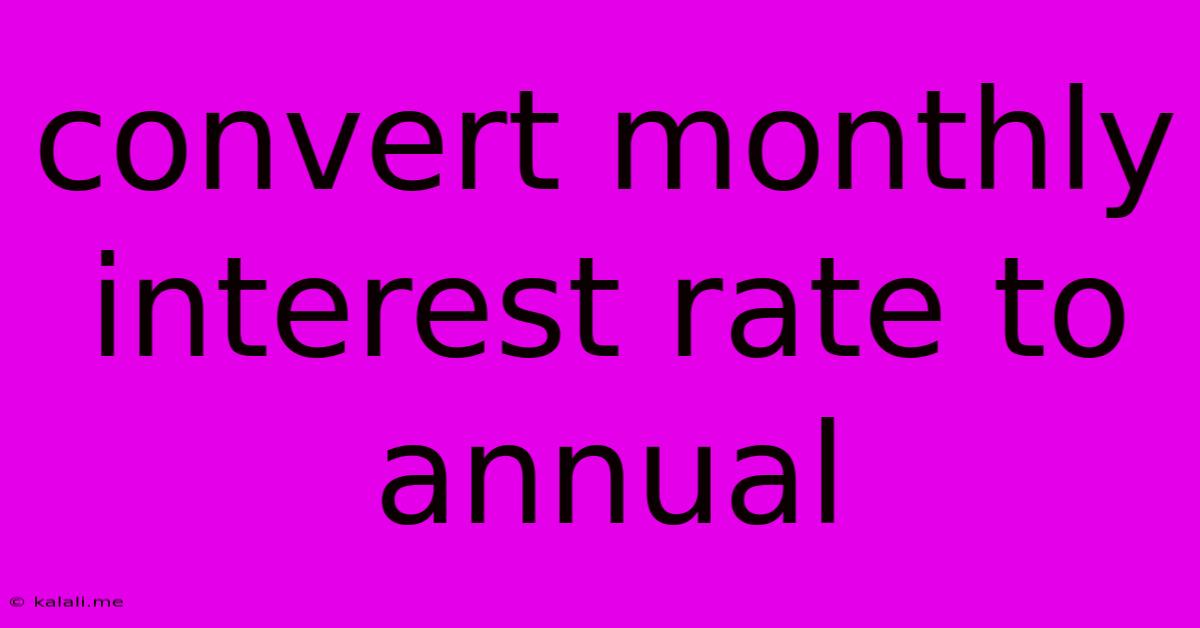Convert Monthly Interest Rate To Annual
Kalali
May 20, 2025 · 3 min read

Table of Contents
Converting Monthly Interest Rate to Annual: A Simple Guide
Understanding how to convert monthly interest rates to annual interest rates is crucial for anyone managing finances, investing, or simply comparing loan offers. Whether you're evaluating a credit card's APR, calculating the return on an investment, or comparing loan terms, knowing how to perform this conversion is essential. This article provides a clear and concise explanation of the process, including practical examples and considerations.
Why is this conversion important? Annual interest rates provide a standardized way to compare different financial products. Monthly rates, while convenient for some calculations, can be misleading when trying to compare options with different compounding periods. Converting to an annual rate allows for a "apples-to-apples" comparison.
Understanding Compound Interest
Before diving into the conversion, it's essential to understand the concept of compound interest. Compound interest is interest earned not only on the principal amount but also on accumulated interest from previous periods. This means your earnings grow exponentially over time. The frequency of compounding (monthly, quarterly, annually) significantly impacts the final amount.
The Formula for Conversion
The formula for converting a monthly interest rate to an annual interest rate is straightforward:
(1 + monthly interest rate)^12 - 1 = annual interest rate
Let's break this down:
- monthly interest rate: This is your monthly interest rate expressed as a decimal (e.g., 1% becomes 0.01).
- 12: This represents the number of months in a year.
- ^12: This signifies raising the result to the power of 12, accounting for the compounding effect over the year.
- -1: This subtracts the initial principal to isolate the annual interest earned.
The resulting decimal is then multiplied by 100 to express the annual interest rate as a percentage.
Example Calculations
Let's illustrate with a few examples:
Example 1: Low Monthly Interest Rate
Suppose you have a savings account with a monthly interest rate of 0.5% (0.005 as a decimal).
(1 + 0.005)^12 - 1 = (1.005)^12 - 1 ≈ 0.0616778
Multiplying by 100, the annual interest rate is approximately 6.17%.
Example 2: High Monthly Interest Rate
Let's say you have a loan with a monthly interest rate of 2% (0.02 as a decimal).
(1 + 0.02)^12 - 1 = (1.02)^12 - 1 ≈ 0.2682418
Multiplying by 100, the annual interest rate is approximately 26.82%.
Important Considerations
- Accuracy: While the formula above is precise, calculators or spreadsheets may provide slightly varying results due to rounding.
- Nominal vs. Effective Interest Rate: The annual interest rate calculated using this method is the effective annual rate, which accurately reflects the total interest earned considering compounding. The nominal annual rate is simply the monthly rate multiplied by 12, but it doesn't account for compounding and therefore underestimates the true annual return. Always aim to use the effective annual rate for accurate comparisons.
- Other Compounding Periods: If the interest compounds quarterly, the formula would be (1 + quarterly rate)^4 -1. Adjust the exponent accordingly based on the compounding frequency.
By understanding the formula and applying these examples, you can confidently convert monthly interest rates to annual rates, facilitating informed financial decisions. Remember to always double-check your calculations and consider the nuances of compound interest for accurate assessments.
Latest Posts
Latest Posts
-
Is An Integrated Masters A Postgraduate Degree
May 20, 2025
-
Convert Three Phase To Single Phase
May 20, 2025
-
Login Failed For User Token Identified Principal
May 20, 2025
-
Difference Between A 2 Stroke And A 4 Stroke
May 20, 2025
-
How To Add Songs To Ipod Without Itunes
May 20, 2025
Related Post
Thank you for visiting our website which covers about Convert Monthly Interest Rate To Annual . We hope the information provided has been useful to you. Feel free to contact us if you have any questions or need further assistance. See you next time and don't miss to bookmark.